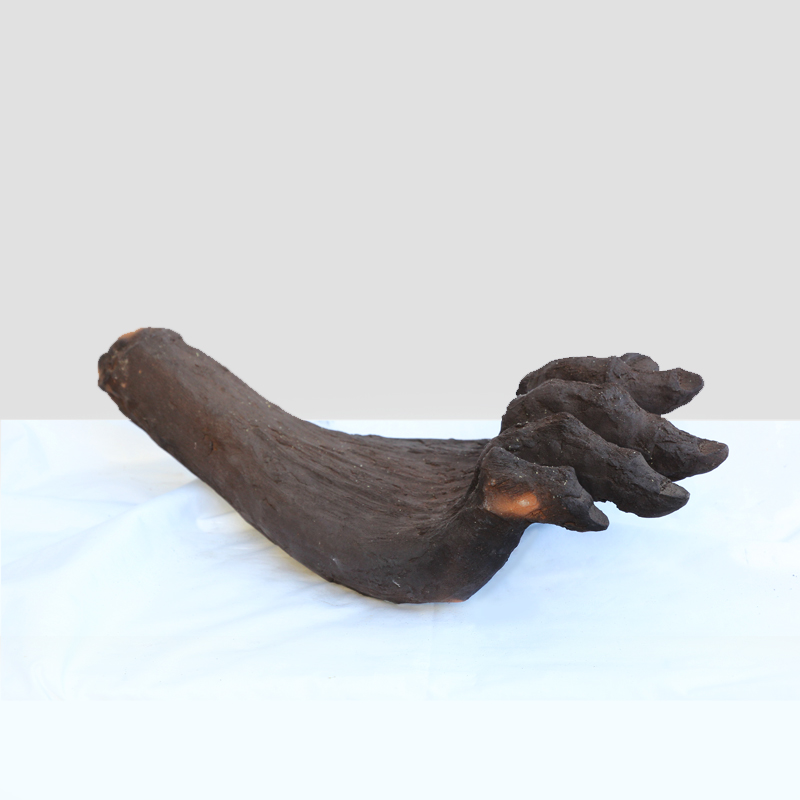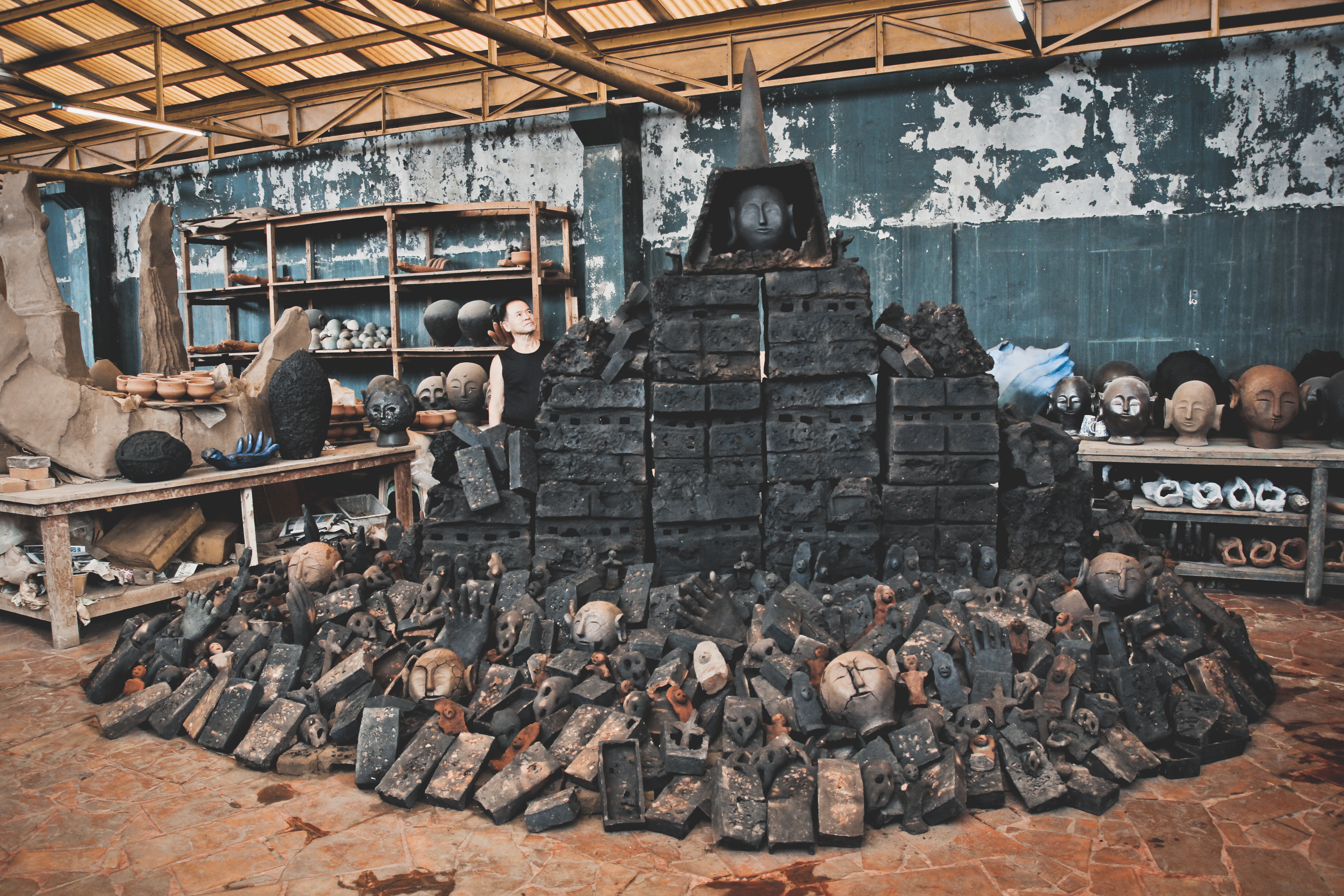

Takeshi Maruyama
Maruyama is an award winning ceramic sculptor from the Yamaguchi Prefecture in Japan who is currently a Resident Artist at Foundation University. After graduating from Kanagwa University in Japan with a Bachelor's Degree in Literature, Maruyama worked in his home country as a manuscript editor for nine years, before finding his true passion in ceramic sculpting at the age of 29. He has not looked back since and has spent the last 43 years perfecting his craft and using it to satiate his powerful inner need to create. Much of Maruyama's recent work mirrors his fascination with the concept of physical deterioration caused by time and its counter balance, rebirth.
2004
Solo Art Exhibition
Pinto Gallery, Manila
2003
Solo Art Exhibition
Ayala, Manila
2002
"Love, Fire, Life"
Solo Art Exhibition
GSIS Museum, Manila
Portfolio
When asked, as he often is, Maruyama does not describe himself as a religious man, but rather a man with a fascination for the religious, and religious art in particular. "I wish I could believe in a God, I envy those who do wholeheartedly and unquestioningly. For them, their religion is their salvation, but for me, my art is my own means for salvation." Spirituality has a huge part to play in the creative process of Maruyama's work however, as he often ascribes the inspiration for his ideas as coming from a higher power. "When I am creating religious statues like Buddha or Mama Maria, I pray throughout the process. My hope is to create a finished piece of art that holds an aura of dignity, that - when looked upon - compels the viewer to join their palms together and pray".
"We human beings exist in ‘space’ and together with that, we exist in ‘time’. As for ‘time’, the end is expected, that is ‘ruins’, that means death. A certain architect said, "when I plan a structure, I expect the end of the structure. In other words, ‘ruins’.” I thought, this architect is a rare, unique one. He is an architect and a poet. Normally, when you think of a structure, it's in space, but when we think of it in time, we must think of ruins, inevitably.
With ruins that have been eroded, nothing seems to exist inside the ruins, but actually, because of that, only the essence of the structure remains. Nature produced that. Which is so very beautiful. Maybe we can compare it to a Haiku. A Haiku carves down the words to just the essence. In a Haiku, only the essence of the words remain. Like a transparent crystal. I can see this deep inside ruins, too. Normally, it's invisible. But invisible things exist. We can see, feel, invisible things, and gradually we begin to notice there's an indescribable, mysterious something in ruins. In this moment, we will be filled with the feeling of prayer. We don't know why, but we want to join our palms naturally.
The essence of ruins, beautiful and divine, gives us peace of mind, and mercy. There's immortality in the essence of ruins that tells us the greatness, and wonderfulness, and depth of ruins. So whenever I stand in front of ruins, I join palms naturally, and want to pray, pray to the sky. The tower on the top of the ruins symbolises the prayer. The prayer goes up to the sky, to the Universe, endlessly.
My work, ‘Ruins’ (subtitle: 'Prayer to Sky').
Oh, Ruins on my mind, I pray.
Just pray to the sky."
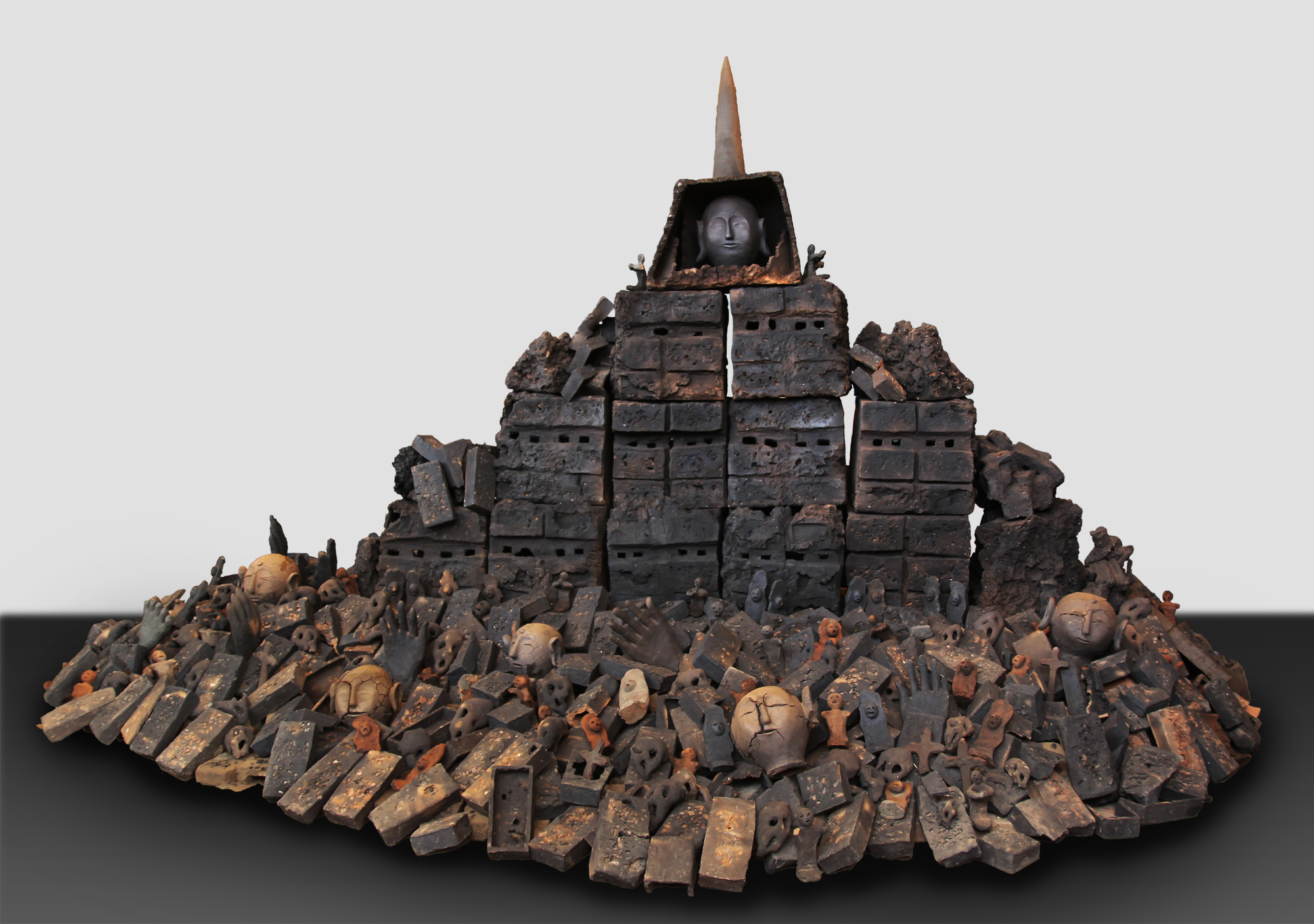
Maruyama believes that the most important features in the artistic representation of Buddha are his head and his hands. Therefore, the head and many expressions of Buddha and Buddhist Monks and Nuns are often the subjects of the artist's ceramic works. His most recent series of heads however, depict an icon of Christianity; the Virgin Mary. Maruyama was moved to create this series of disfigured 'Mama Maria' statues after watching a news report on churches situated within Nagasaki; one of the two Japanese cities that were devastated by nuclear bombs during World War II. "When I saw that the churches had retained the Mama Maria statues that had been severely damaged by the bombs, I was so deeply moved. It was a a greatly honourable sign of respect for those particular statues and what they had endured, and to look at them, they are so dignified and carry a much deeper meaning".
Maruyama believes that the most important features in the artistic representation of Buddha are his head and his hands. Therefore, hands are often the subject of the artist's ceramic works. His most recent series of 'distorted hands' however, hold within them a much darker story. They pay homage to the victims of Minamata disease, caused by the unscrupulous dumping of toxic waste into the ocean by a chemical factory in the Kumamoto prefecture in Japan for over three decades in the mid 1900s. These waters provided food and livelihood for the thousands of residents in nearby fishing villages, and the severe mercury poisoning distorted their hands along with many other horrific symptoms, and even proved fatal for more than half of its victims.
Publications
Smoke billows around him, translucent wisps of pearl wrapping around his short stocky body like an ethereal cloak before flowing up the wall of the nearby building and dissipating into a gray haze above the rooftop. His piercing brown eyes are locked intently on the source of the smoke, a chest-high square cinder block structure with two metal doors covering the top and two smaller shoulder width openings at ground level, one in the front and one in the back. Licks of flame shoot out from the opening directly into his front as he moves forward to crouch in front of it. Sweat seeps out of his wide brow, beading up then running unnoticed down his cheeks, pausing for just a moment to hang from his square jaw before plummeting into the pile of wood he is now energetically feeding to the hungry flames. "More!" he suddenly barks over his shoulder as he gestures to the diminishing pile. A fleeting feminine form darts out from behind him and through the door of the nearby building, emerging moments later with a bundle of wood clutched tightly in her arms.
She drops the wood into the pile, then steps back and waits
for further instructions, watching her mentor's every move
as he carefully inspects the fresh batch of wood, picking out
select pieces and adding them into the inferno.
This same process has been repeated several times over
the past month, but each time the delicate balance the
artist has been searching for was missing. Worthless. All
the elements must be right, the heat, the shade of smoke
created by the type of wood, the amount of time he leaves
his creation inside the smouldering kiln to be cured. It must
be precise and if he is not satisfied, then he and his
apprentice will try again...and again, until the kiln is truly
ready. Ready to give birth to his clay children. They are the
physical manifestations of his inner soul and he will not
turn them over to the kiln's glowing womb until he's sure.
An extract from 'Master and Apprentice'
by Phil Prins, Foundation University, 2015
Available Works
 Non-Titled 1
Non-Titled 1 approx 45 x 15 x 12 in
 Non-Titled 2
Non-Titled 2 approx 40 x 16 x 15 in
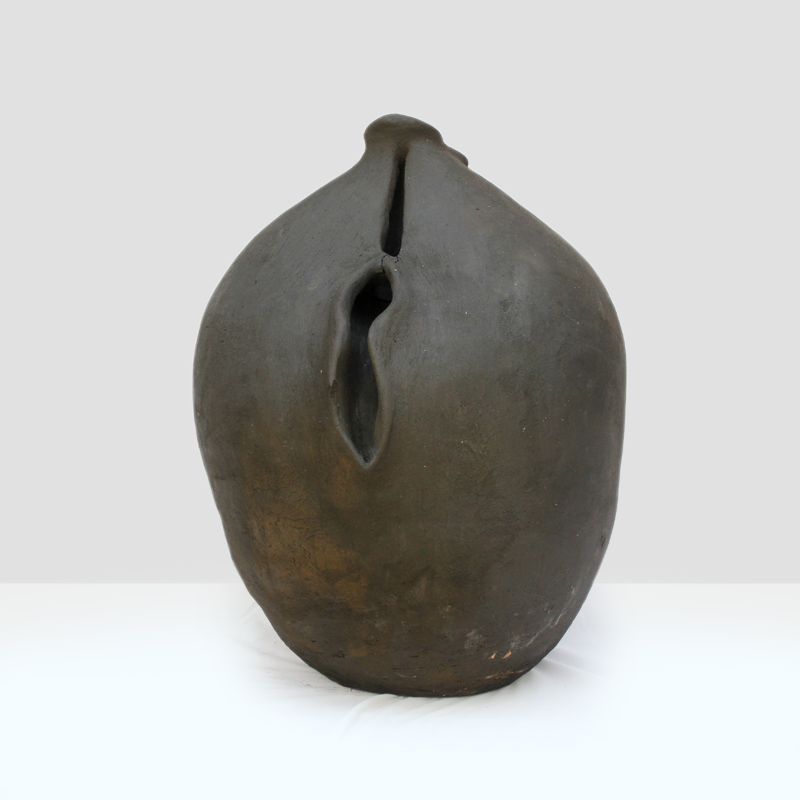 Vase 1
Vase 1 approx 13 x 20 x 15 in
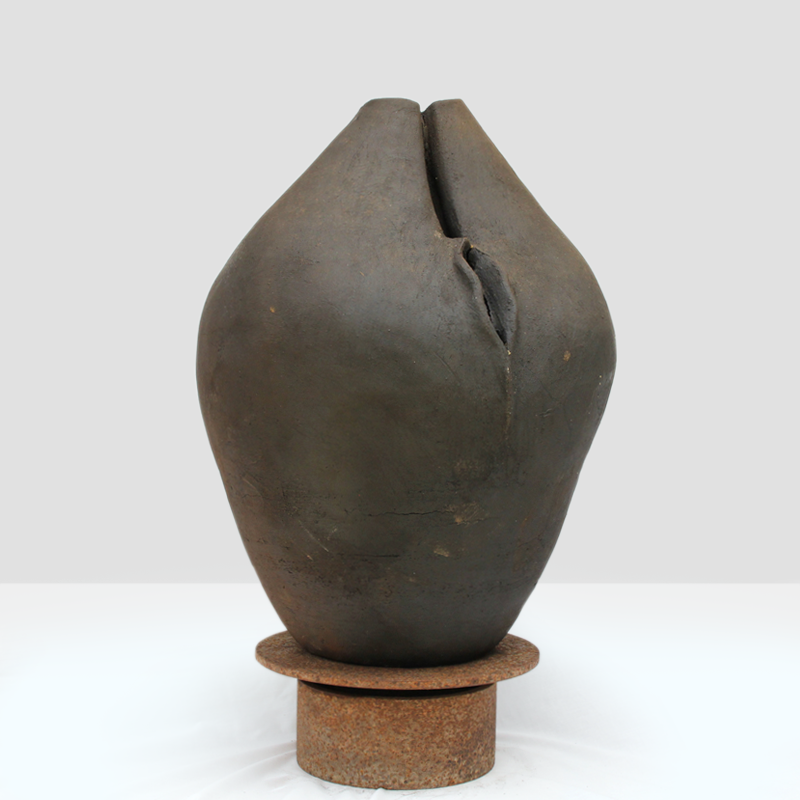 Vase 2
Vase 2 approx 14 x 20 x 13 in
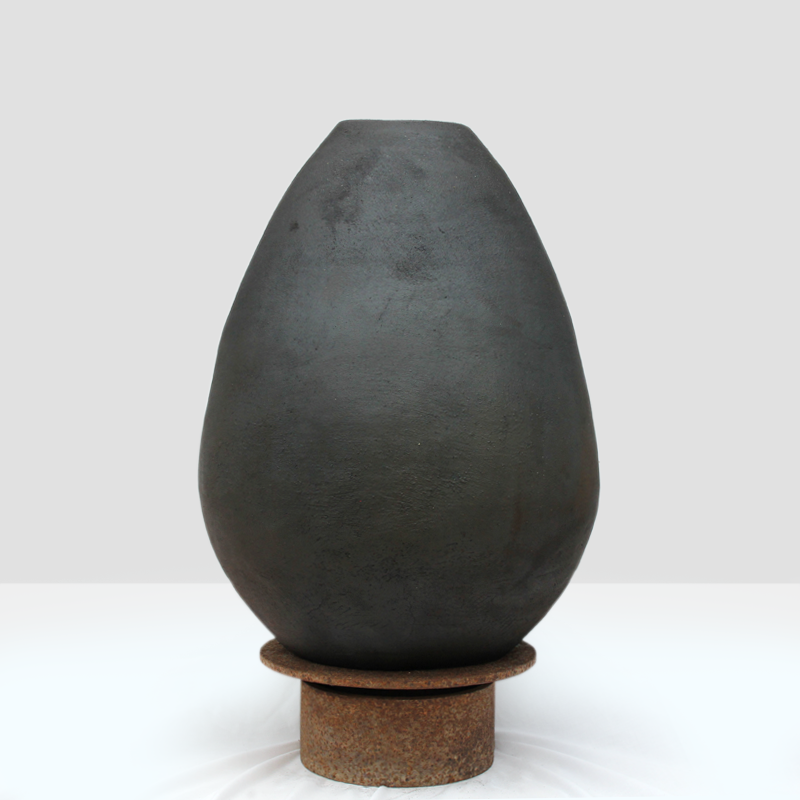 Vase 3
Vase 3 approx 13 x 19 x 13 in
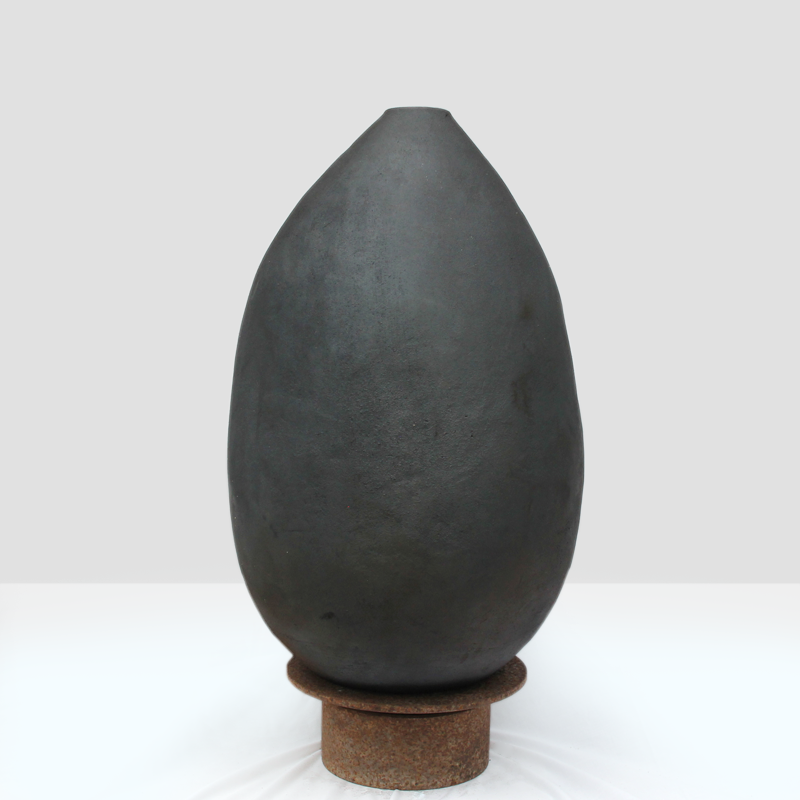 Vase 4
Vase 4 approx 13 x 23 x 13 in
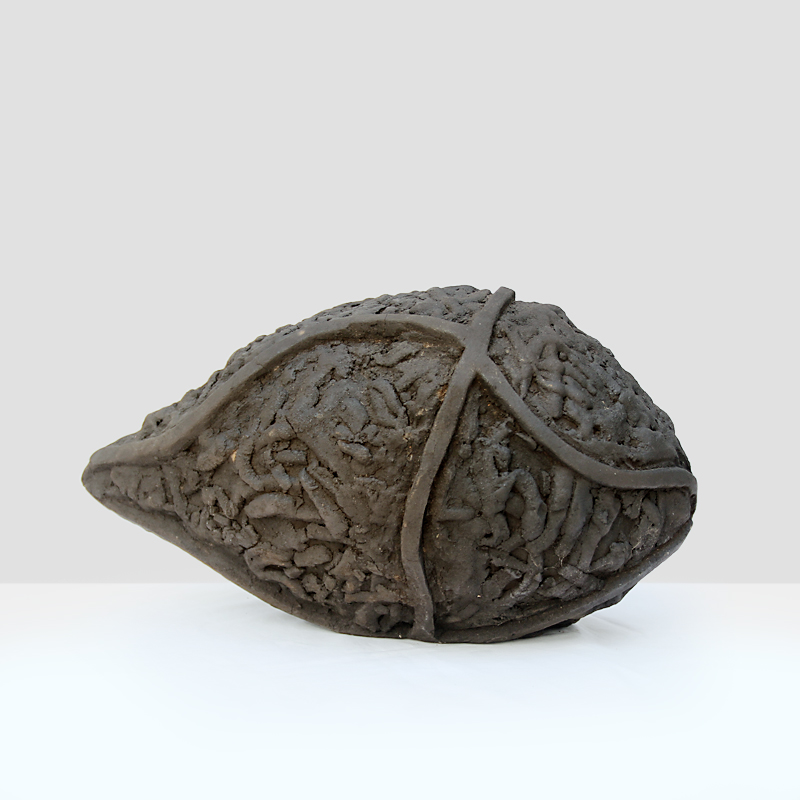 Cosmos 1
Cosmos 1 approx 19.5 x 10 x 10 in
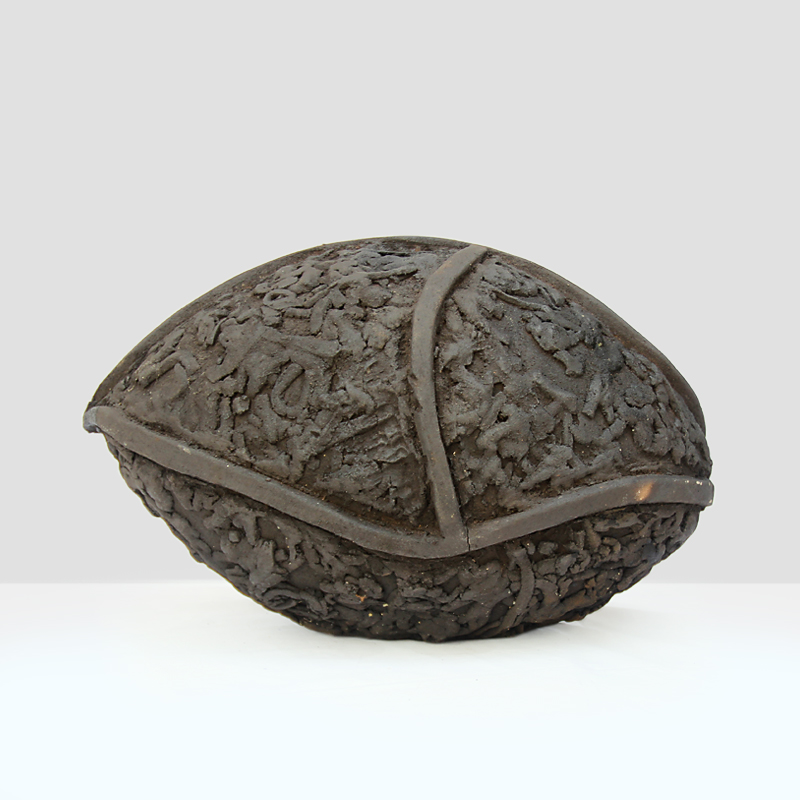 Cosmos 2
Cosmos 2 approx 18 x 11 x 10 in
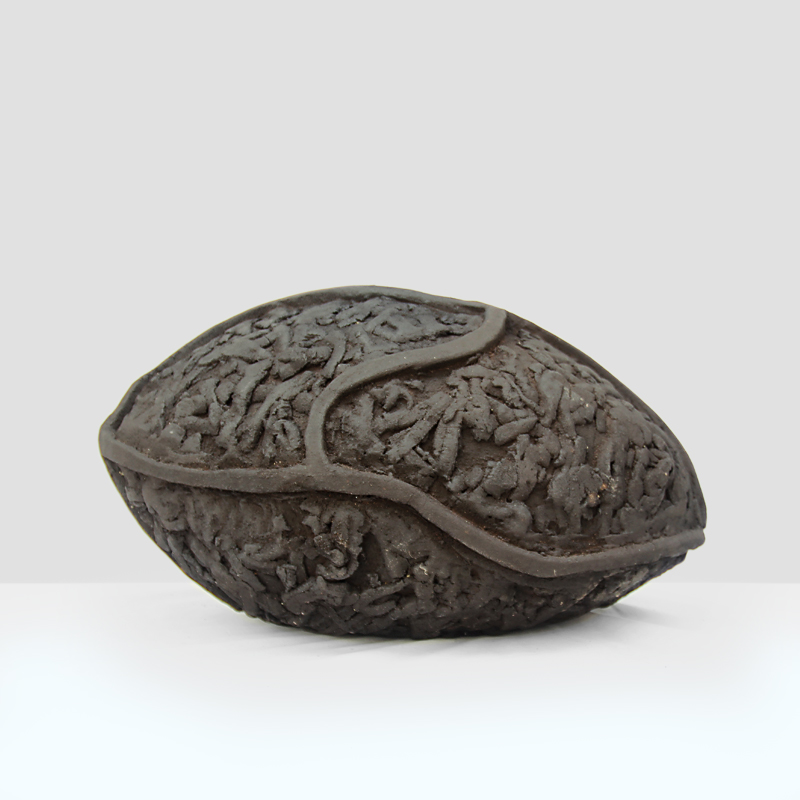 Cosmos 3
Cosmos 3 approx 18 x 10 x 11 in
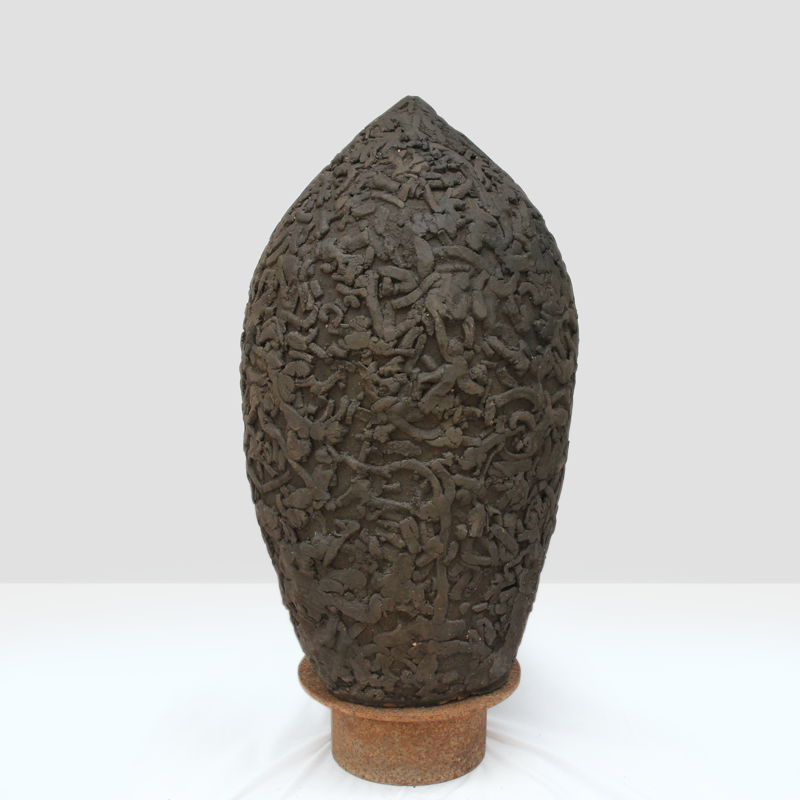 Universe
Universe approx 13 x 26 x 12 in
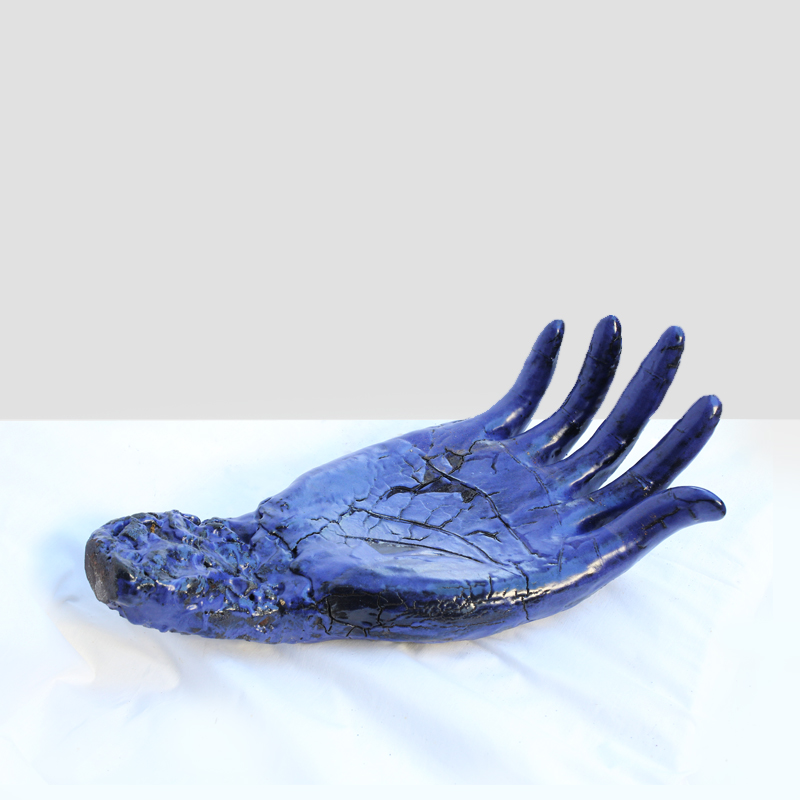 Buddha's Hand 1
Buddha's Hand 1 approx 20.5 x 7.5 x 9.5 in
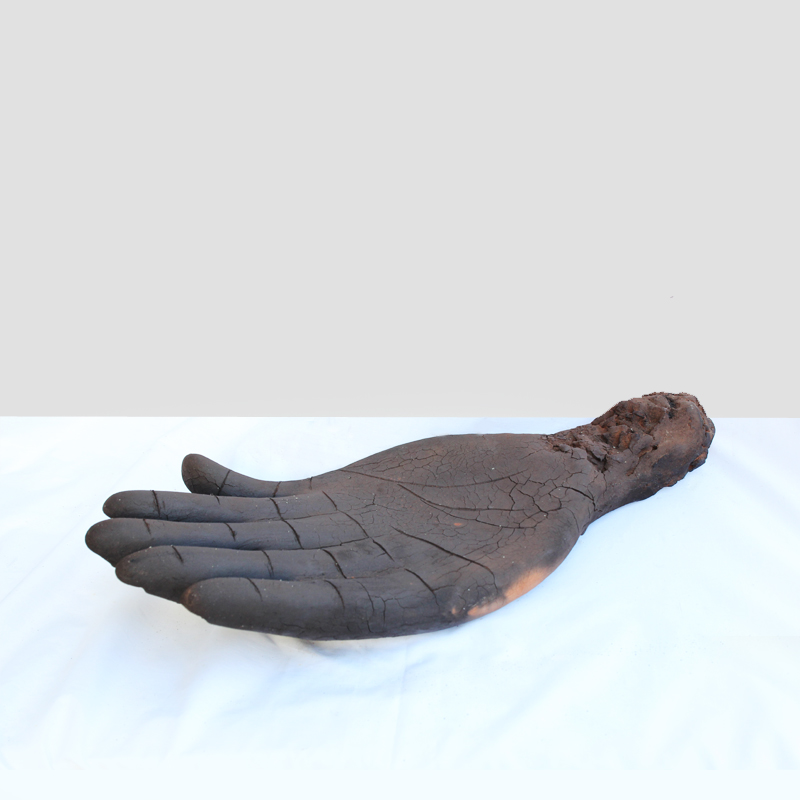 Buddha's Hand 2
Buddha's Hand 2 approx 25 x 5.5 x 9 in
 Buddha's Hand 3
Buddha's Hand 3 approx 21 x 2.5 x 9 in
 Buddha's Hand 4
Buddha's Hand 4 approx 19.5 x 2.5 x 7 in
 Mama Maria
Mama Maria approx 13 x 17 x 13 in
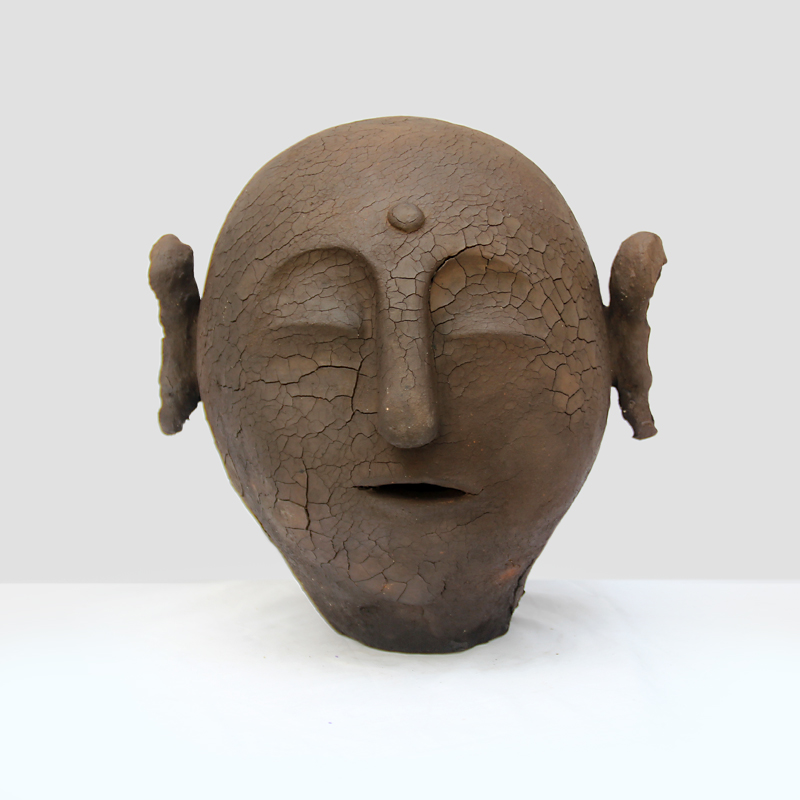 Statue of a Nun 1
Statue of a Nun 1 approx 15 x 13.5 x 12 in
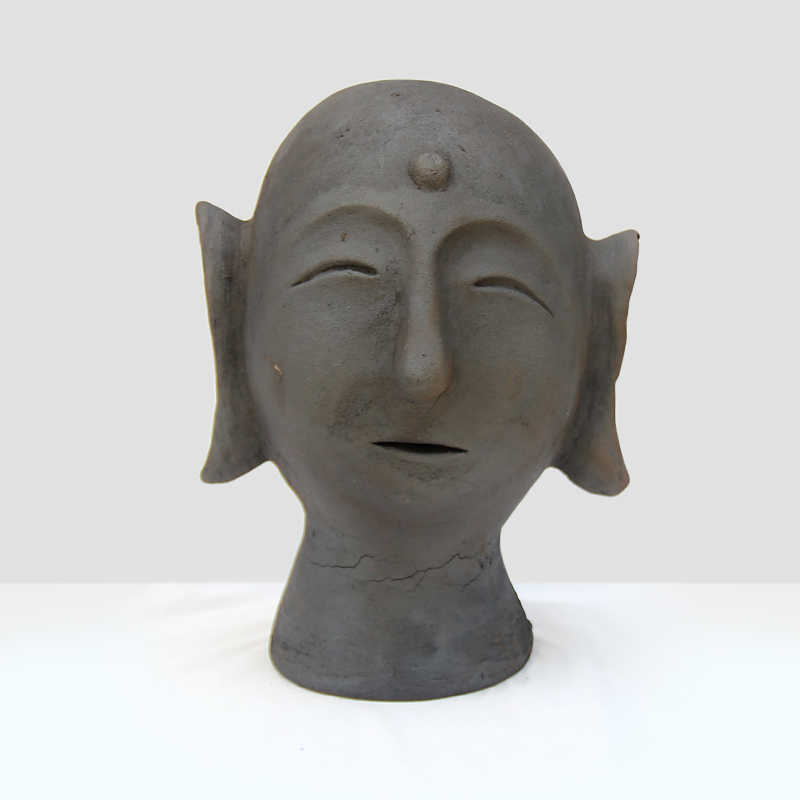 Statue of a Nun 2
Statue of a Nun 2 approx 112 x 16 x 10 in
 Statue of a Nun 3
Statue of a Nun 3 approx 11 x 14 x 9 in
 Statue of a Nun 4
Statue of a Nun 4 approx 11 x 14.5 x 10 in
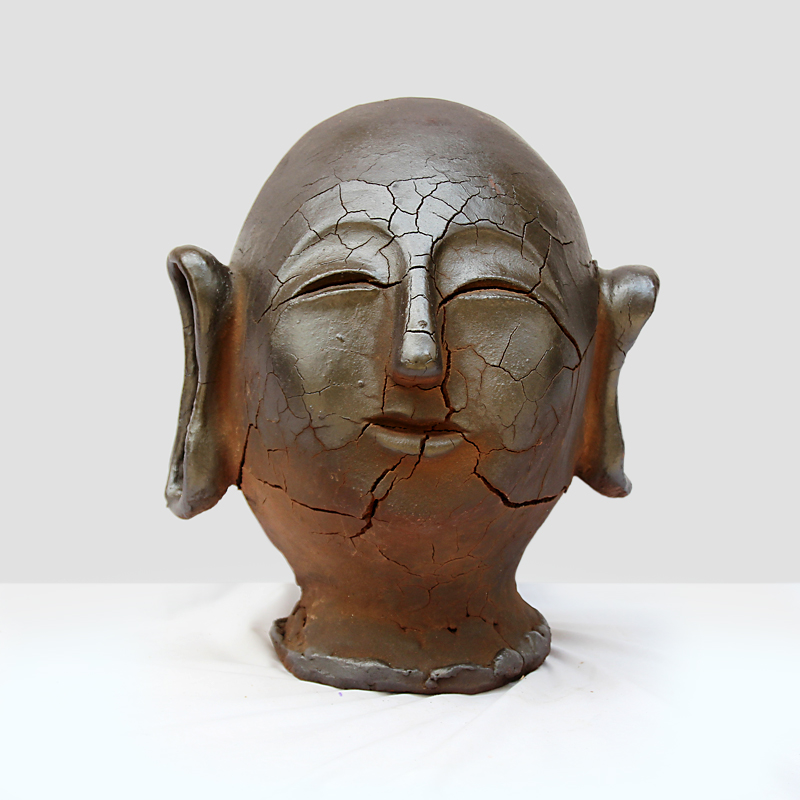 Statue of a Nun 5
Statue of a Nun 5 approx 11 x 14 x 11 in
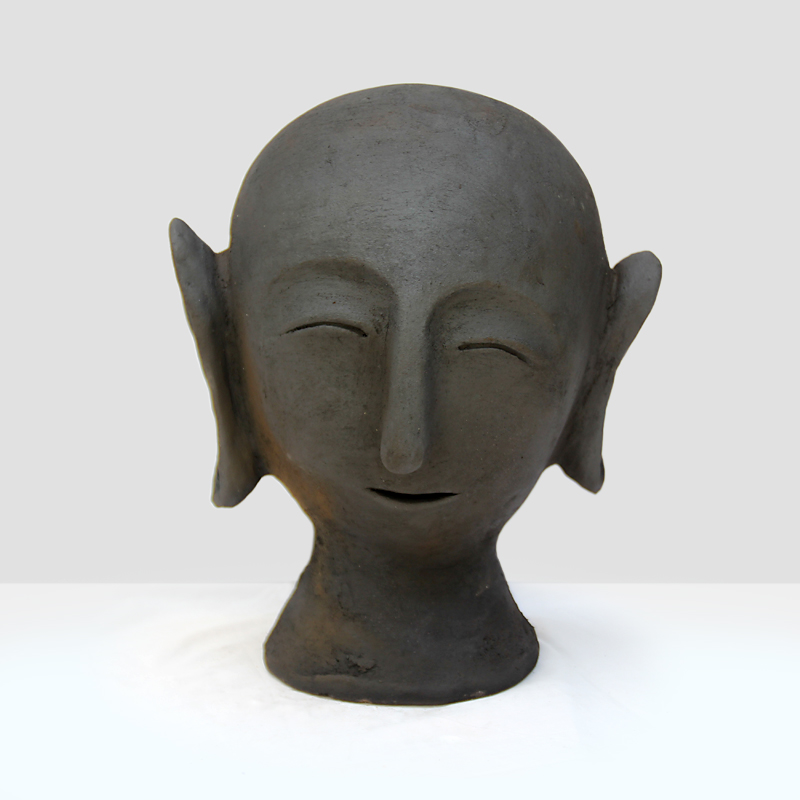 Statue of a Nun 6
Statue of a Nun 6 approx 12 x 15.5 x 10 in
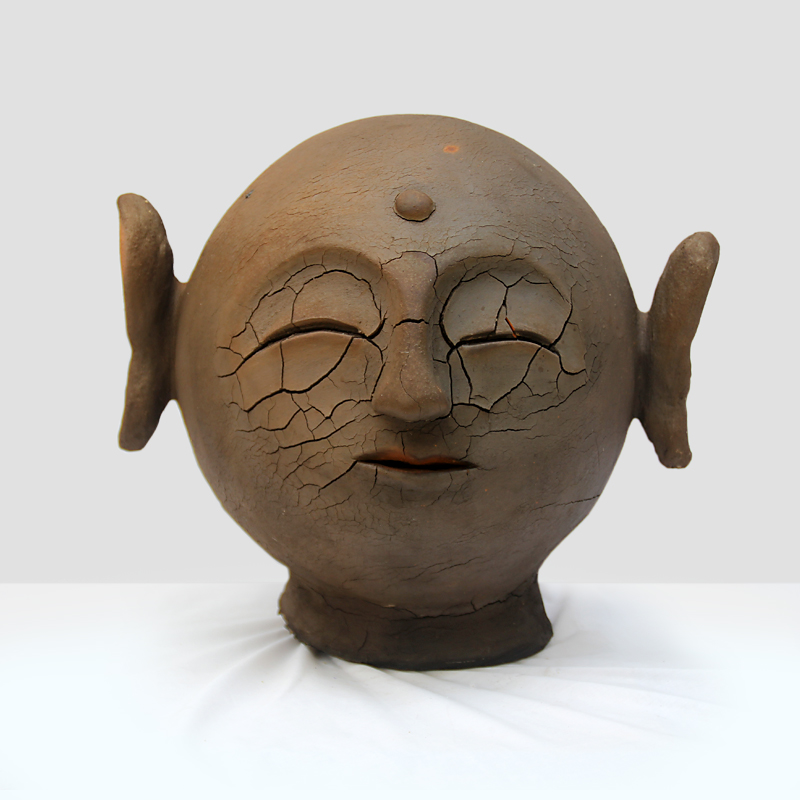 Statue of a Monk
Statue of a Monk approx 16 x 14 x 13 in
 Tea Bowl 1
Tea Bowl 1 approx 4.5 x 3.25 x 4.5 in
 Tea Bowl 2
Tea Bowl 2 approx 4.5 x 3.25 x 4.5 in
 Tea Bowl 3
Tea Bowl 3 approx 5.25 x 3.75 x 5.25 in
 Tea Bowl 4
Tea Bowl 4 approx 5 x 3.5 x 5 in
 Tea Bowl 5
Tea Bowl 5 approx 5.5 x 3.5 x 5.5 in
 Tea Bowl 6
Tea Bowl 6 approx 6 x 3.5 x 6 in
 Tea Bowl 7
Tea Bowl 7 approx 5.75 x 3.5 x 5.75 in
 Tea Bowl 8
Tea Bowl 8 approx 5.75 x 3.5 x 5.75 in
 Tea Bowl 9
Tea Bowl 9 approx 5.5 x 3.5 x 5.5 in
 Tea Bowl 10
Tea Bowl 10 approx 6 x 3.75 x 6 in
Contact
A. Foundation University North Campus
Dr. V. Locsin Street Dumaguete City
Philippines 6200
E. takeshibond@gmail.com
I. @maruyama.ceramicart
Monday to Friday:
10am - 12pm, 2pm - 4pm
© 2025 Takeshi Maruyama, Foundation University, Dumaguete City, PH.







